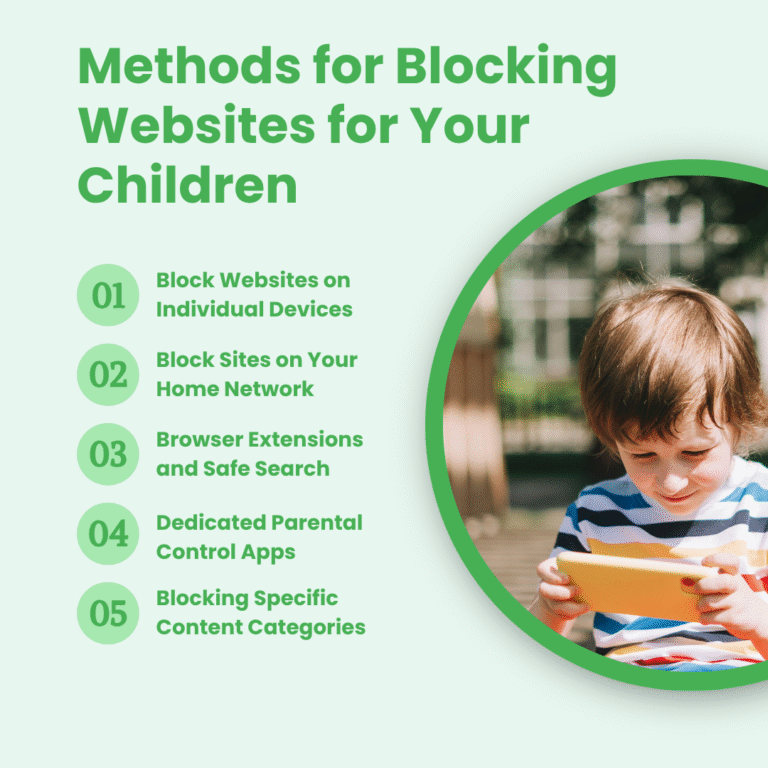As a parent, keeping your kids safe online is probably high on your priority list. With children spending more time on devices than ever before, knowing how to block inappropriate websites has become an essential skill in your parenting toolkit.
This guide walks you through multiple ways to block websites on different devices, from simple built-in controls to whole-home solutions. Whether you’re tech-savvy or just getting started, you’ll find practical steps that work for your family’s needs.
Why Block Websites for Children?
Kids are naturally curious, and the internet is full of content they’re not ready for. Even innocent searches can lead to:
- Explicit or violent content
- Online predators in chat rooms or games
- Scams targeting young users
- Endless distractions from homework and sleep
- Social media pressures
The good news? You have plenty of options to create safer online spaces for your children while still letting them enjoy the benefits of technology.

Method 1: Block Websites on Individual Devices
iPhone and iPad (iOS)
Apple’s built-in Screen Time feature makes it easy to block websites:
Open Settings and tap Screen Time
Tap “Content & Privacy Restrictions”
Enable restrictions by toggling the switch
Tap “Content Restrictions” → “Web Content”
Choose your restriction level:
“Unrestricted Access” (not recommended)
“Limit Adult Websites”
“Allowed Websites Only”
To block specific sites:
Select “Limit Adult Websites”
Scroll down to “Never Allow”
Tap “Add Website” and enter the site address
For younger kids, the “Allowed Websites Only” option limits browsing to only kid-friendly sites like PBS Kids and Disney.
Android Devices
Google Family Link gives you control over your child’s Android device:
- Download Google Family Link on both your phone and your child’s
- Follow the setup instructions to link accounts
- Once connected, open Family Link on your phone
- Select your child’s profile
- Tap “Settings” → “Google Chrome” → “Manage sites”
- Choose “Approved sites only” or “Blocked sites”
- Add specific websites to either list
For Chrome specifically:
- Open Chrome on your child’s device
- Tap the three dots → Settings → “Safe Browsing”
- Select “Enhanced protection” for maximum safety
For more comprehensive protection on Android, MMGuardian’s parental control app offers advanced web filtering that works across browsers and can’t be easily disabled by tech-savvy kids.
Windows PCs
Set up Microsoft Family Safety to manage website access:
- Create a child account at account.microsoft.com/family
- Add your child to your family group
- Sign in to your child’s device with their account
- Go to family.microsoft.com
- Select your child’s profile
- Click “Content filters”
- Turn on “Filter inappropriate websites”
- Add specific websites to block or allow
Mac Computers
Use Screen Time controls on macOS:
- Click the Apple menu → System Preferences → Screen Time
- Select your child’s account (or set up Family Sharing first)
- Click “Content & Privacy”
- Select the “Web Content” tab
- Choose “Limit Adult Websites” or “Allowed Websites Only”
- Add specific sites to your custom lists
Method 2: Block Sites on Your Home Network
Blocking websites at the router level affects all devices connected to your home Wi-Fi—a great solution for families with multiple devices.
Router Parental Controls
Most modern routers have built-in filtering:
- Find your router’s IP address (often printed on the router or in its manual)
- Type the IP address in your browser (common ones are 192.168.0.1 or 192.168.1.1)
- Log in with the admin username and password
- Look for “Parental Controls” or “Access Restrictions”
- Enter websites to block or select content categories
- Save your settings
Can’t find parental controls? Your router might not have them, or they might be limited. Consider upgrading to a router with better parental controls like Netgear’s Nighthawk series or Asus routers with AiProtection.
OpenDNS Setup
OpenDNS is a free service that filters content at the network level:
- Create an account at opendns.com
- Go to your router’s settings
- Find the DNS settings
- Replace your current DNS with OpenDNS addresses:
- Primary: 208.67.222.222
- Secondary: 208.67.220.220
- Save settings and restart your router
- Log into your OpenDNS dashboard to customize filtering levels
The free version blocks phishing sites and lets you choose from pre-set filtering levels. The paid “Home VIP” version ($19.95/year) adds customizable filtering and usage logs.
Method 3: Browser Extensions and Safe Search
Browser extensions offer a quick way to block websites, though tech-savvy kids might find ways around them.
Chrome Extensions
- BlockSite: Easily block websites and set schedules
- FamilyLink: Block sites and set time limits
- WebFilter Pro: Filter by categories like gambling or adult content
Firefox Extensions
- Block Site: Similar to Chrome’s BlockSite
- LeechBlock NG: Block time-wasting sites during homework hours
Safe Search Settings
Enable safe search on popular search engines:
Google:
- Go to google.com
- Click “Settings” at bottom right
- Select “Search Settings”
- Turn on “SafeSearch”
YouTube:
- Sign in to YouTube
- Click your profile picture → Settings
- Select “Restricted Mode” at the bottom
- Toggle it on
For younger children, consider kid-friendly search engines like Kiddle or KidzSearch.
Method 4: Dedicated Parental Control Apps
For the most comprehensive protection, parental control apps offer features beyond simple website blocking.
| App | Best For | Website Blocking | App Control | Screen Time | Price |
|---|---|---|---|---|---|
| MMGuardian | Complete monitoring | Advanced AI filtering | Yes | Yes | $4.99–$9.99/mo |
| Net Nanny | Content filtering | Category-based | Yes | Yes | $39.99–$89.99/yr |
| Qustodio | Multiple devices | Real-time filtering | Yes | Yes | $54.95–$137.95/yr |
| Bark | Alert-based monitoring | Limited blocking | No | No | $5–$14/mo |
MMGuardian Kids Phone
For parents of younger children or preteens, the MMGuardian Kids Phone comes with comprehensive protection built in. Unlike regular phones where kids might uninstall parental controls, this solution can’t be tampered with. It includes Safety Alerts that notify you about potential cyberbullying or inappropriate content, along with location tracking and customizable web filtering—all managed from your own phone.
Method 5: Blocking Specific Content Categories
Different ages need different levels of protection. Here’s what to consider by category:
Blocking Adult Content
- Use the “Restrict Adult Sites” option on iOS and macOS
- Enable “SafeSearch” on all search engines
- Consider OpenDNS’s “Moderate” filtering level for preteens
Social Media
For younger children (under 13):
- Block social media sites completely through router settings
- Use app blocking features to prevent installation
For teens:
- Consider time limits instead of complete blocks
- Use monitoring tools to stay aware of potential issues
Gaming Sites
- Block specific gaming sites during school hours
- Set up screen time schedules that allow gaming only after homework
- Use router scheduling to disable internet access during sleeping hours
Tips to Prevent Circumvention
Smart kids often find workarounds for website blocks. Stay one step ahead:
- Use passwords on parental control settings
- Disable guest browsing on all browsers
- Block VPN services that could bypass your filters
- Check browser history regularly
- Keep devices in common areas of your home
- Talk openly about why certain content is restricted
Most importantly, maintain an ongoing conversation about internet safety. Blocks and filters work best when combined with education about online risks and responsible digital citizenship.
Finding the Right Balance
The best approach combines technical solutions with open communication:
- Start with basic protections like SafeSearch and device-level controls
- Add network-level filtering for whole-home protection
- Consider a comprehensive solution like MMGuardian for peace of mind
- Adjust restrictions as your children mature
- Keep talking about online safety as an ongoing conversation
Remember that the goal isn’t just to block content but to teach your children how to navigate the digital world safely and responsibly. As they demonstrate good judgment, you can gradually adjust restrictions to give them more freedom.
By layering different methods—device controls, network filtering, and possibly parental control apps—you’ll create a safer online environment where your children can learn, play, and grow with appropriate boundaries.






